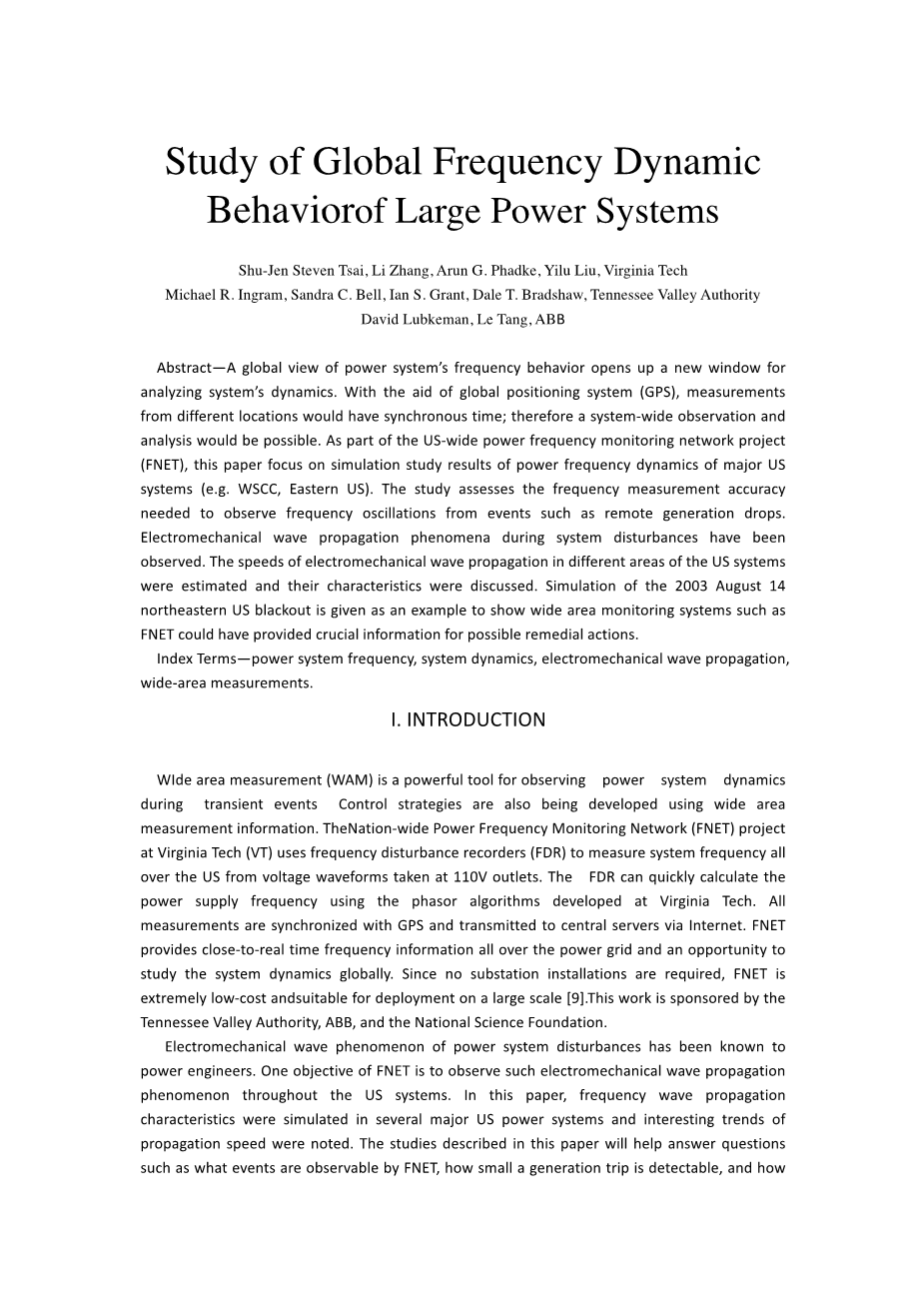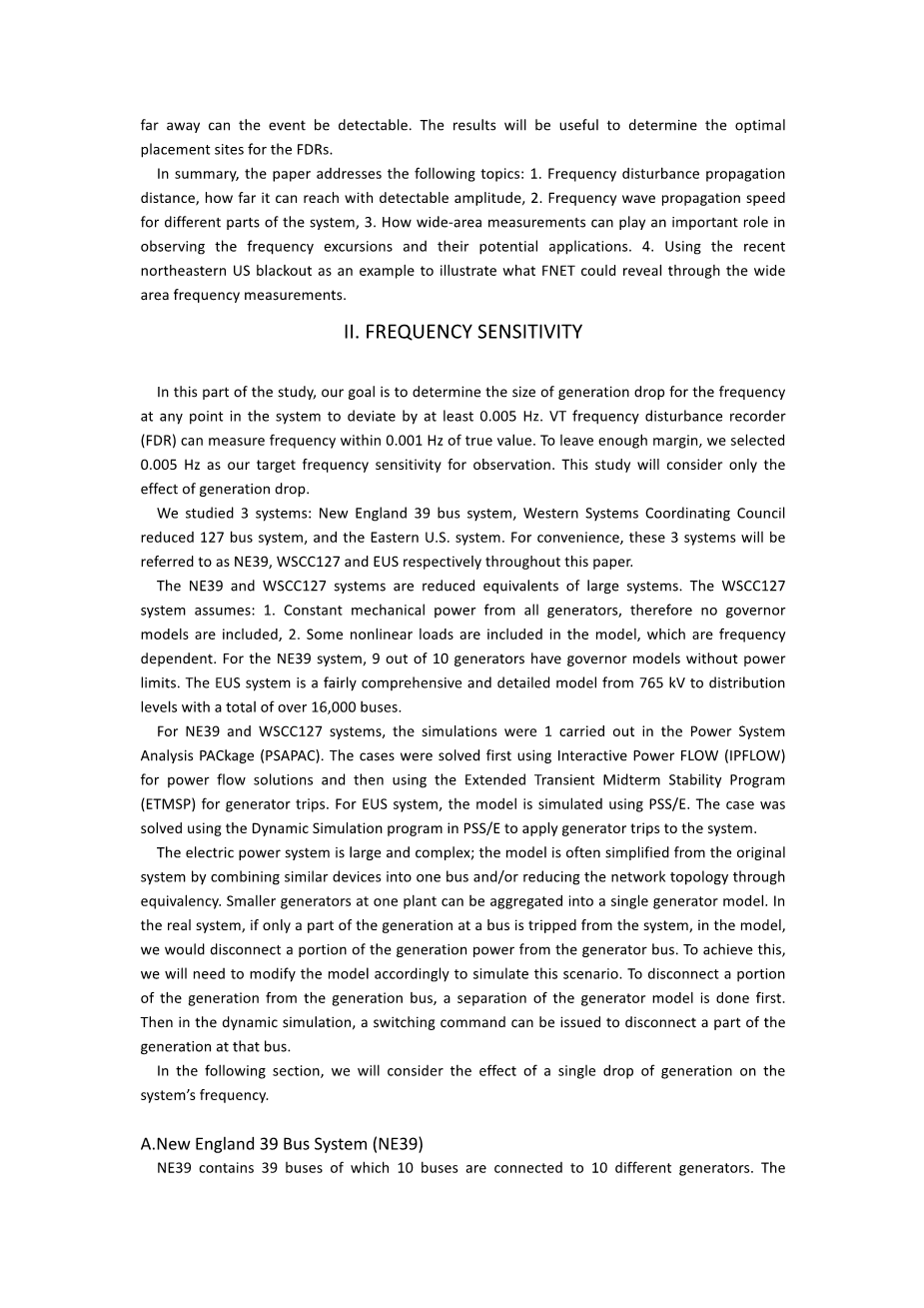

英语原文共 14 页,剩余内容已隐藏,支付完成后下载完整资料
1
Study of Global Frequency Dynamic Behavior
of Large Power Systems
Shu-Jen Steven Tsai, Li Zhang, Arun G. Phadke, Yilu Liu, Virginia Tech
Michael R. Ingram, Sandra C. Bell, Ian S. Grant, Dale T. Bradshaw, Tennessee Valley Authority
David Lubkeman, Le Tang, ABB
Abstract—A global view of power systemrsquo;s frequency behavior opens up a new window for analyzing systemrsquo;s dynamics. With the aid of global positioning system (GPS), measurements from different locations would have synchronous time; therefore a system-wide observation and analysis would be possible. As part of the US-wide power frequency monitoring network project (FNET), this paper focus on simulation study results of power frequency dynamics of major US systems (e.g. WSCC, Eastern US). The study assesses the frequency measurement accuracy needed to observe frequency oscillations from events such as remote generation drops. Electromechanical wave propagation phenomena during system disturbances have been observed. The speeds of electromechanical wave propagation in different areas of the US systems were estimated and their characteristics were discussed. Simulation of the 2003 August 14 northeastern US blackout is given as an example to show wide area monitoring systems such as FNET could have provided crucial information for possible remedial actions.
Index Terms—power system frequency, system dynamics, electromechanical wave propagation, wide-area measurements.
I. INTRODUCTION
Wide area measurement (WAM) is a powerful tool for observing power system dynamics during transient events
[1]. Control strategies are also being developed using wide area measurement information [2-7]. The Nation-wide Power Frequency Monitoring Network (FNET) project at Virginia Tech (VT) uses frequency disturbance recorders (FDR) to measure system frequency all over the US from voltage waveforms taken at 110V outlets. The FDR can quickly calculate the power supply frequency using the phasor algorithms developed at Virginia Tech [8]. All measurements are synchronized with GPS and transmitted to central servers via Internet. FNET provides close-to-real time frequency information all over the power grid and an opportunity to study the system dynamics globally. Since no substation installations are required, FNET is extremely low-cost and suitable for deployment on a large scale [9].
This work is sponsored by the Tennessee Valley Authority, ABB, and the National Science Foundation.
Electromechanical wave phenomenon of power system disturbances has been known to power engineers [10, 11]. One objective of FNET is to observe such electromechanical wave propagation phenomenon throughout the US systems. In this paper, frequency wave propagation characteristics were
simulated in several major US power systems and interesting trends of propagation speed were noted. The studies described in this paper will help answer questions such as what events are observable by FNET, how small a generation trip is detectable, and how far away can the event be detectable. The results will be useful to determine the optimal placement sites for the FDRs.
In summary, the paper addresses the following topics: 1. Frequency disturbance propagation distance, how far it can reach with detectable amplitude, 2. Frequency wave propagation speed for different parts of the system, 3. How wide-area measurements can play an important role in observing the frequency excursions and their potential applications. 4. Using the recent northeastern US blackout as an example to illustrate what FNET could reveal through the wide area frequency measurements.
II. FREQUENCY SENSITIVITY
In this part of the study, our goal is to determine the size of generation drop for the frequency at any point in the system to deviate by at least 0.005 Hz. VT frequency disturbance recorder (FDR) can measure frequency within 0.001 Hz of true value. To leave enough margin, we selected 0.005 Hz as our target frequency sensitivity for observation. This study will consider only the effect of generation drop.
We studied 3 systems: New England 39 bus system, Western Systems Coordinating Council reduced 127 bus system, and the Eastern U.S. system. For convenience, these 3 systems will be referred to as NE39, WSCC127 and EUS respectively throughout this paper.
The NE39 and WSCC127 systems are reduced equivalents of large systems. The WSCC127 system assumes: 1. Constant mechanical power from all generators, therefore no governor models are included, 2. Some nonlinear loads are included in the model, which are frequency dependent. For the NE39 system, 9 out of 10 generators have governor models without power limits. The EUS system is a fairly comprehensive and detailed model from 765 kV to distribution levels with a total of over 16,000 buses.
For NE39 and WSCC127 systems, the simulations were
1
carried out in the Power System Analysis PACkage (PSAPAC). The cases were solved first using Interactive Power FLOW (IPFLOW) for power flow solutions and then using the Extended Transient Midterm Stability Program (ETMSP) for generator trips. For EUS system, the model is simulated using PSS/E. The case was solved using the Dynamic Simulation program in PSS/E to apply generator trips to the system.
The electric power system is large and complex; the model is often simplified from the original system by combining similar devices into one bus and/or reducing the network topology through equivalency. Smaller generators at one plant can be aggregated into a single generator model. In the real system, if only a part of the generation at a bus is tripped from the system, in the model, we would disconnect a portion of the generation power from the generator bus. To achieve this, we will need to modify the
剩余内容已隐藏,支付完成后下载完整资料
资料编号:[613048],资料为PDF文档或Word文档,PDF文档可免费转换为Word


